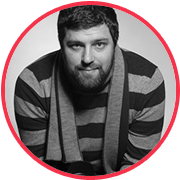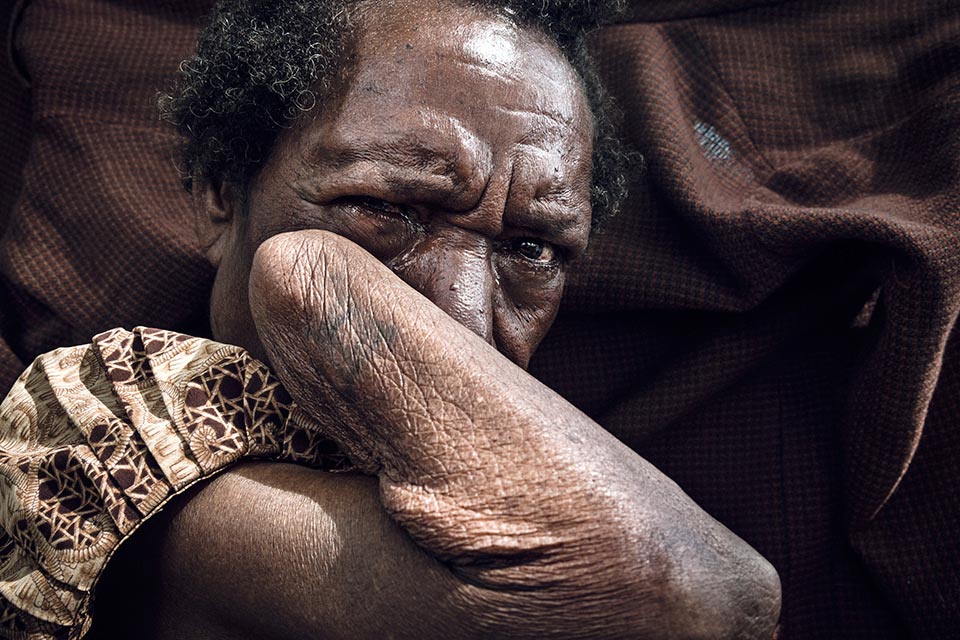
I chose the photographs that have more than a simple aesthetic perception. Every one of these photographs feels close to me, as I not only saw a beautiful picture, but also felt something on the inside, and those emotions still remind me of the moments when I was with the characters of my pictures.
One of the photographs from the series about childhood slavery in Haiti.
In the picture you see 11 year old Etienne and his master. From early hours until late at night Etienne works in a shop in Cite Soleil, the most dangerous and the poorest slum in Port-au-Prince. He sleeps on the floor, and his master gives him some food, but he is often hungry. The master did not want to be photographed at first, but then he saw that I was making pictures of Etienne, so he approached us and started posing. I deliberately chose a picture where you cannot see the eyes of the slave owner. The neighbors told me he beat Etienne up all the time, but I could see it in his eyes anyway.
{“img”: “/wp-content/uploads/2015/05/vlad_sokhin01.jpg”, “alt”: “Vlad Sokhin”, “text”: “”}
Children play “cemetery” on Ebeye island (Marshall Islands).
Ebeye is one of the strangest places on earth that I’ve been to. In the mid-20th century American military were testing nuclear bombs on atolls of Marshall Islands and moved many of their inhabitants from test sites to a tiny island in the middle of the Pacific Ocean. Now about 15 thousand people live on the territory of 0.36 sq.km. This place is called the slum of the Pacific, and it is not easy to get there, as the only airport close to the island belongs to the American military, and they are not very fond of journalists and photographers. The island itself is not only overpopulated, it constantly suffers from various epidemics: tuberculosis, cholera, poliomyelitis, leprosy. Unemployment and absence of hope for the future makes many people there depressed, and I caught a bit of this depression in the ten days that I lived and worked there. One time at night I was wandering around the island and I saw children digging themselves into the sand on one of the beaches. I asked what they were playing, and they told me they were playing “cemetery. I thought that was deeply symbolic.
{“img”: “/wp-content/uploads/2015/05/vlad_sokhin02.jpg”, “alt”: “Vlad Sokhin”, “text”: “”}
Half-submerged village of Aberao in the remote Kiribati country.
It is a photograph from my new unfinished project about climate change in the Pacific region. I made a lot of photographs for this project in the past two years in Papua New Guinea, Kiribati, Vanuatu, Tuvalu, Niue and the Marshall Islands. When I just started working on this project, I offered the editor of a German magazine to publish this story, but they declined – citing that there is no 100% scientific proof that the climate is changing and the ocean levels are rising. In Kiribati I saw every day how during high water whole villages get submerged. In the houses parents tie their children to heavy objects so they wouldn’t fall down in the water and drown. In traditional houses built on poles water often reaches floor level and even flows inside. After a couple years of filming such climate change I have no doubt that it is really happening.
{“img”: “/wp-content/uploads/2015/05/vlad_sokhin03.jpg”, “alt”: “Vlad Sokhin”, “text”: “”}
Portrait of a rapist in his prison cell in Papua New Guinea.
I worked in Papua for almost 3 years, I have flown there 11 times, spent overall more than a year in the country. Most of the time there was spent photographing the project about violence against women in the country that turned into a book, Crying Meri, published last year by PhotoEvidence. When I first came to the country they let me visit a local prison for murderers and rapists. The policeman took me to the corridor between the cells and let me walk along the corridor for some time and talk to the inmates. At first many refused to talk to me and be photographed, but when the policeman left they started reaching out their arms to be from behind the bars, grabbing me and shouting something like, “Take a picture of me, take a picture of me, I killed my wife.”
At first I took a picture of this man when he was sitting on the floor with the neighbor inmates, found out what crime he committed, and left. When I was walking back towards the exit and passed his cell, he was standing like this and waiting for me. I had time to make several pictures, and then the policeman returned and told me it was time to leave.
{“img”: “/wp-content/uploads/2015/05/vlad_sokhin04.jpg”, “alt”: “Vlad Sokhin”, “text”: “”}
A pregnant woman in a hospital on Normanby Island in Papua New Guinea.
Together with the journalist Jo Chandler I was working on a story about one Australian doctor who helps pregnant women in the most remote parts of the country. As soon as we arrived on this island by boat we were met by the police who told us to be careful – there are armed pirates in the neighborhood who attack boats, take fuel and motors and leave people to drift on the open sea. We spent several days on the island and our doctor decided to go back to Alotau, the capital of the province, as this woman had complications. She was expecting twins and walked alone a long way to the hospital on foot. It was decided to insert a catheter in advance, to be able to insert medication in case she started birthing while we were on the boat. I took this photograph when she was lying down after the doctor’s examination. Then we packed, helped her on the boat, and started our 4-hour way back. The doctor told our captain to go slowly, so as not to cause premature labor with the impact of the waves on the sides of the boat. Soon another boat tried to catch up with us. When they drew near, we saw big men with angry faces. We understood immediately who they were. The doctor and I stood closer to the board and waited for what was going to happen. Pirates went side by side with us for ten minutes, and all this time they were looking at us and at the pregnant woman, and they didn’t say a word. Then they slowed down and went to the shore. Later the doctor said that our motor had much more power, but he did not increase our speed, or they could have started shooting at us, and the woman could have started contractions. The next day she successfully delivered twins in Alotau hospital.
{“img”: “/wp-content/uploads/2015/05/vlad_sokhin05.jpg”, “alt”: “Vlad Sokhin”, “text”: “”}
Cite Soleil slum in Port-au-Prince, Haiti.
I wandered into this place accidentally with my translator who lived there himself. We ended up near some piece of water, everything was covered in tons of trash, and there were some chimneys on the other side. Some locals were sitting in all this filth and playing dominos. The situation seemed apocalyptically unreal. The locals, of course, did not want to see the foreigner with a camera, so they started being aggressive. My translator Willy was talking to them for a while, and finally they calmed down and continued their game, and they let me take pictures.
{“img”: “/wp-content/uploads/2015/05/vlad_sokhin06.jpg”, “alt”: “Vlad Sokhin”, “text”: “”}
Portrait of Rasta from Papua New Guinea.
After a boy died in Rasta’s settlement in 2003, she was accused of witchcraft. The crowd attacked Rasta during the funeral. They beat her, cut her with knives and tried to strangle her, but she managed to escape. Trying to protect herself from a machete strike, she lost her hand. I made this portrait on one of the mountain roads of New Guinea. Local human rights activists introduced us at one of the local villages, but she asked not to photograph her when other people were around. We had to go for some distance from the settlement, and while I was shooting we were talking about what had happened. Suddenly Rasta burst into tears from emotions, and started wiping the tears of with her mutilated hand. From then on we became friends, I came to see her in the village several more times, we often call each other. Last year she managed to get a prosthetic, and her abusers apologized to her daughter, but never to Rasta herself.
{“img”: “/wp-content/uploads/2015/05/vlad_sokhin07.jpg”, “alt”: “Vlad Sokhin”, “text”: “”}
From “The Time of the Crocodiles” series in Mozambique.
In 2010 I lived in Mozambique where I was working on several stories at a time. One of them – “The Time of the Crocodiles” – is about how locals get attacked by crocodiles near Zambezi river all the time. I took this picture in the orphanage of Boromo village in Tete province. The orphanage is housed in the building of the former Catholic mission right near the river, where the children take water from and bathe. Those who go to the river are often accompanied by Joao the guard with his Kalashnikov ready. If the come across and kill a crocodile, the children eat his meat for lunch. I spent several days walking to the river with the orphanage kids, but to no avail. In the orphanage there were skins of the alligators killed by the guard. I went to some storage room with Joao and the kids from the orphanage to have a look at one them. I was warned about a black mamba, one of the most poisonous snakes on the planet, who lives in dry grass on the floor of the storage. That’s why the kids slowly went to retrieve the skin from dry grass, and they were banging with a stick on the floor to scare off the snake. Joao sat down and was also knocking with his gun on the floor slightly. I took this picture when he lit a cigarette.
{“img”: “/wp-content/uploads/2015/05/vlad_sokhin08.jpg”, “alt”: “Vlad Sokhin”, “text”: “”}
A night club in Port Moresby, the capital of Papua New Guinea.
Night clubs here are not the safest in the world, especially during the weekend parties. Hundreds of absolutely drunk and out of control locals are relaxing there on the weekends. I always photographed there with bodyguards, who were protecting me from overly annoying clients who tried to mount me for some reason, or tried to hug the only foreigner. In this picture you see the club bodyguard who is taking rest after his shift on the billiards table. I took the picture when I was photographing the giving out of free condoms to sex workers who come here looking for clients for one non-governmental organization.
{“img”: “/wp-content/uploads/2015/05/vlad_sokhin09.jpg”, “alt”: “Vlad Sokhin”, “text”: “”}
Sanghita’s Room in Bhakrapur, Nepal
I took this picture two weeks ago when I was working in Nepal on the story about the aftermath of the earthquake for the Russian Reporter. I wandered around the debris of Bhaktapur city near Katmandu, and I suddenly saw Sanghita inside one of the collapsed buildings. This was her room, the only one left in the house. It was a lucky coincidence that Sanghita and her mom were inside when the earthquake started. They managed to survive, and on that day they came back to their house to take the remaining belongings. When I was shooting, I was followed by the smell of decomposition, and Sanghita said that not everyone was retrieved from the debris yet. I think this house would have completely collapsed by now, as earthquake shocks continue in Nepal.
{“img”: “/wp-content/uploads/2015/05/vlad_sokhin10.jpg”, “alt”: “Vlad Sokhin”, “text”: “”}





